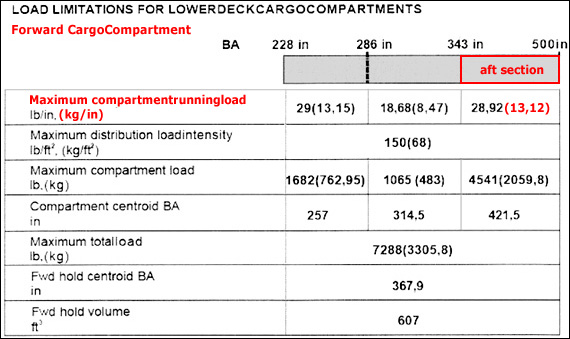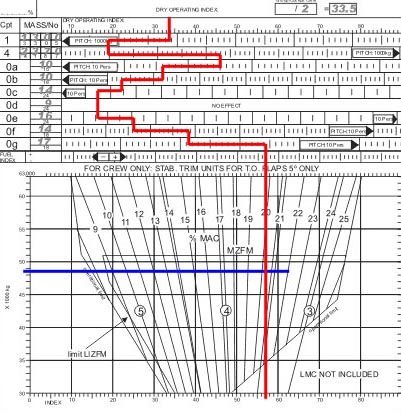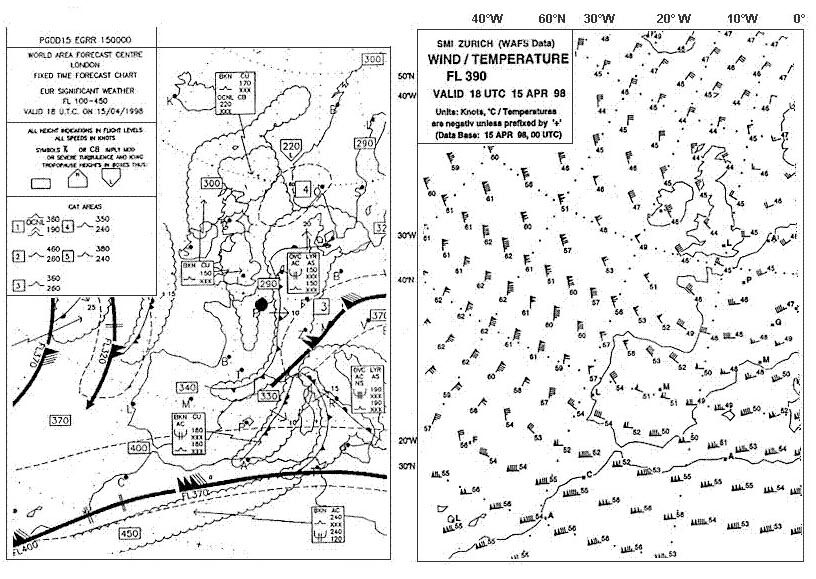During a final approach the flight director system is engaged in the loc mode ? [ Experience lift off ]
Question 66-1 : The correction on the bank to be applied to join and follow the localizer axis the position of the aircraft relative to the localizer axis the instantaneous deviation between the aircraft position and the localizer axis the roll attitude of the aircraft
 The correction on the bank to be applied to join and follow the localizer axis.
The correction on the bank to be applied to join and follow the localizer axis. Flying manually during a final approach the flight director system is engaged ?
Question 66-2 : May be centred if the pilot is correcting to come back on to the ils glide slope cannot be centred is automatically centred since the g/s mode is engaged will be centred only when establish on the ils glide slope
 May be centred if the pilot is correcting to come back on to the ils glide slope.
May be centred if the pilot is correcting to come back on to the ils glide slope. Flying manually during a final approach the flight director system is engaged ?
Question 66-3 : May be centred if the pilot is correcting to come back on the ils glide slope is automatically centred since the g/s mode is engaged deviates upward whatever the attitude of the aircraft is deviates downward whatever the attitude of the aircraft is
 May be centred if the pilot is correcting to come back on the ils glide slope.
May be centred if the pilot is correcting to come back on the ils glide slope. Flying manually during a final approach the flight director system is engaged ?
Question 66-4 : May be centred if the pilot is correcting to come back on the localizer axis is automatically centred since the loc mode is engaged deviates to the left whatever the attitude of the aircraft is deviates to the right whatever the attitude of the aircraft is
 May be centred if the pilot is correcting to come back on the localizer axis.
May be centred if the pilot is correcting to come back on the localizer axis. Flying manually during a final approach the flight director system is engaged ?
Question 66-5 : May be centred if the pilot is correcting to come back on the localizer axis cannot be centred is automatically centred since the loc mode is engaged will be centred only when establish on the localizer axis
The flight director is engaged in the heading select mode hdg sel heading ?
Question 66-6 : Is centered if the bank angle of the aircraft is equal to the bank angle computed by the flight director calculator is centered if the aircraft has a 20° left drift is centered if the aircraft has a 20° right drift cannot be centered
 Is centered if the bank angle of the aircraft is equal to the bank angle computed by the flight director calculator.
Is centered if the bank angle of the aircraft is equal to the bank angle computed by the flight director calculator. The flight director provides information for the pilot ?
Question 66-7 : To join to a desired path with the optimum attitude to remain within the flight envelope to join a desired track with a 45° intercept angle to join a desired track with a constant bank angle of 25°
The horizontal command bar of a flight director ?
Question 66-8 : Gives information about the direction and the amplitude of the corrections to be applied on the pitch of the aircraft repeats the position information given by the ils in the horizontal plane repeats the position information given by the ils in the vertical plane gives information only about the direction of the corrections to be applied on the pitch of the aircraft
 Gives information about the direction and the amplitude of the corrections to be applied on the pitch of the aircraft.
Gives information about the direction and the amplitude of the corrections to be applied on the pitch of the aircraft. The horizontal command bar of a flight director .1 repeats the position ?
Question 66-9 : 3 1 3 2 3 2
 3
3 The parameters taken into account by the flight director computer in the ?
Question 66-10 : 1 4 1 3 1 2 1
 1, 4.
1, 4. The purpose of a flight director is to ?
Question 66-11 : Reduce the pilots workload by presenting data in the form of control commands convey air traffic control information to the pilot provide an automatic landing system function automatically steer the aircraft to waypoints selected on the cdu
 Reduce the pilots workload by presenting data in the form of control commands.
Reduce the pilots workload by presenting data in the form of control commands. The vertical command bar of a flight director ?
Question 66-12 : Gives information about the direction and the amplitude of the corrections to be applied on the bank of the aircraft repeats the position information given by the ils in the horizontal plane repeats the position information given by the ils in the vertical plane gives information only about the direction of the corrections to be applied on the bank of the aircraft
 Gives information about the direction and the amplitude of the corrections to be applied on the bank of the aircraft.
Gives information about the direction and the amplitude of the corrections to be applied on the bank of the aircraft. The vertical command bar of a flight director .1 repeats the position ?
Question 66-13 : 3 1 2 3 1 3 2 3
 3.
3. To allow the coupling of a dual channel flight director ?
Question 66-14 : Both autopilot channels must be selected on only one autopilot channel must be selected on both vhf comms channels must be serviceable both vhf nav channels must be serviceable
 Both autopilot channels must be selected on.
Both autopilot channels must be selected on. An aircraft flies steadily on a heading 270° the flight director is engaged in ?
Question 66-15 : Deviates to the right and will be centred as soon as you roll the aircraft to the bank angle calculated by the flight director deviates to the right and remains in that position until the aircraft has reached heading 360° disappears the new heading selection has deactivated the hdg mode deviates to its right stop as long as the aeroplane is more than 10° off the new selected heading
 Deviates to the right and will be centred as soon as you roll the aircraft to the bank angle calculated by the flight director.
Deviates to the right and will be centred as soon as you roll the aircraft to the bank angle calculated by the flight director. An automatic ils approach can be flown only ?
Question 66-16 : Within a range of crosswinds and levels of turbulence within a range of crosswinds and no limit for turbulence within a range of levels of turbulence and no limit for crosswinds without limits for crosswind or turbulence
 Within a range of crosswinds and levels of turbulence.
Within a range of crosswinds and levels of turbulence. The 'guidance' functions of a autopilot consist in ?
Question 66-17 : Monitoring the movements of the centre of gravity in the three dimensions of space stabilizing and monitoring the movements around the centre of gravity monitoring the movements of the aerodynamic centre in the three dimensions of space stabilizing and monitoring the movements around the aerodynamic centre
 Monitoring the movements of the centre of gravity in the three dimensions of space.
Monitoring the movements of the centre of gravity in the three dimensions of space. The 'airspeed hold' mode can be engaged and maintained during ?
Question 66-18 : Climbs descents turns and power changes climbs and descents only climbs descents and power changes only turns only
 Climbs, descents, turns and power changes.
Climbs, descents, turns and power changes. The output data of the flight director computer are ?
Question 66-19 : Two channels pitch and roll two channels pitch and yaw three channels pitch roll and yaw three channels pitch roll and sideslipping
 Two channels: pitch and roll.
Two channels: pitch and roll. The initiation of an automatic go around can be ?
Question 66-20 : In a range of approach airspeeds with no limit of approach airspeeds at 70kt +/ 5kt only at vy +/ 5kt only
During a final approach if the flight director system is engaged in the g/s ?
Question 66-21 : The correction on the pitch to be applied to join and follow the ils glide slope the position of the aircraft relative to the ils glide slope the instantaneous deviation between the aircraft position and the ils glide slope the pitch attitude of the aircraft
 The correction on the pitch to be applied to join and follow the ils glide slope.
The correction on the pitch to be applied to join and follow the ils glide slope. If in the event of a failure there is no significant out of trim condition or ?
Question 66-22 : Fail passive fail operational fail safe fail redundant
 Fail-passive.
Fail-passive. If in the event of a failure the approach flare and landing can be completed by ?
Question 66-23 : Fail operational faill passive fail soft fail hard
 Fail-operational.
Fail-operational. Considering a flight director of the 'command bars' type ?
Question 66-24 : The horizontal bar is associated with the pitch channel the horizontal bar is associated with the roll channel the vertical bar is associated with the pitch channel the vertical bar may be associated with the pitch channel
 The horizontal bar is associated with the pitch channel.
The horizontal bar is associated with the pitch channel. The command bars of a flight director ?
Question 66-25 : May be displayed when flying manually or with the autopilot engaged are displayed only when flying manually are displayed only when the autopilot is engaged are always displayed during take off
 May be displayed when flying manually or with the autopilot engaged.
May be displayed when flying manually or with the autopilot engaged. The purpose s of the flight director system is are to .1 give the position of ?
Question 66-26 : 3 1 3 2 3 1 2 3
 3.
3. Concerning the command bars of a flight director ?
Question 66-27 : It is possible to remove them by switching the flight director off it is not possible to remove them on some types of flight director systems autopilot must be first disengaged to remove them autopilot must be first engaged before removing them
 It is possible to remove them by switching the flight director off.
It is possible to remove them by switching the flight director off. The lateral flight path modes of an autopilot system are .1 speed hold.2 ?
Question 66-28 : 2 3 4 1 2 3 4 1 3 5 2 4
 2, 3, 4.
2, 3, 4. The purpose of the autopilot control wheel steering cws mode is ?
Question 66-29 : To consider as target parameters the current pitch and roll angles at the time the mode becomes active to control the nose wheel steering during automatic landing to control the nose wheel steering during low visibility take off and landing to capture and hold the altitude selected with the control wheel on the mode control panel
 To consider as target parameters, the current pitch and roll angles at the time the mode becomes active.
To consider as target parameters, the current pitch and roll angles at the time the mode becomes active. When engaged in the fms lateral navigation mode lnav the autopilot uses the ?
Question 66-30 : Fms track selector vor receiver vor or localizer receiver
 Fms.
Fms. In an autopilot system the flight path modes are .1 pitch attitude hold.2 ias ?
Question 66-31 : 2 3 4 1 2 3 4 3 4
 2, 3, 4.
2, 3, 4. The lateral flight path modes of an autopilot system are .1 heading hold.2 ?
Question 66-32 : 1 3 5 1 2 3 5 1 3 4 2 5
 1, 3, 5.
1, 3, 5. The vertical flight path modes of an autopilot system are .1 pitch attitude ?
Question 66-33 : 2 4 1 2 4 1 2 3 1
 2, 4.
2, 4. The automatic synchronisation function of an autopilot control system . 1 ?
Question 66-34 : 3 1 3 1 2 1 2 3
 3.
3. The components of an autopilot system are the .1 actuators.2 mode control ?
Question 66-35 : 1 2 3 4 1 4 1 2 1 2 4
 1, 2, 3, 4.
1, 2, 3, 4. Concerning a fail passive flight control system in the event of a failure .1 ?
Question 66-36 : 2 3 2 4 1 3 1 4
 2, 3.
2, 3. Concerning a fail passive flight control system in the event of a failure . ?
Question 66-37 : 2 3 2 4 1 3 1 4
 2, 3.
2, 3. For a fms designed with the lateral navigation lnav capability coupled to the ?
Question 66-38 : A roll angle or a heading target a longitudinal acceleration and a roll rate a lateral acceleration a calibrated airspeed cas and a cross track distance xtk
 A roll angle or a heading target.
A roll angle or a heading target. The cs 25 gives the following definition 'where the pilot has the ability to ?
Question 66-39 : Control wheel steering cws alternate wheel steering aws nose wheel steering nws automatic wheel steering aws
 Control wheel steering (cws).
Control wheel steering (cws). When engaging the autopilot the function providing a smooth 'take over' is the ?
Question 66-40 : Automatic synchronisation function automatic pitch trim function mach trim function automatic cws control wheel steering function
 Automatic synchronisation function.
Automatic synchronisation function. ~
Exclusive rights reserved. Reproduction prohibited under penalty of prosecution.
2599 Free Training Exam
